
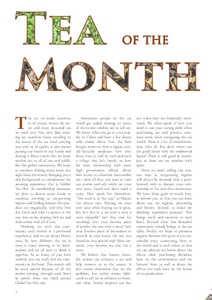 |
|
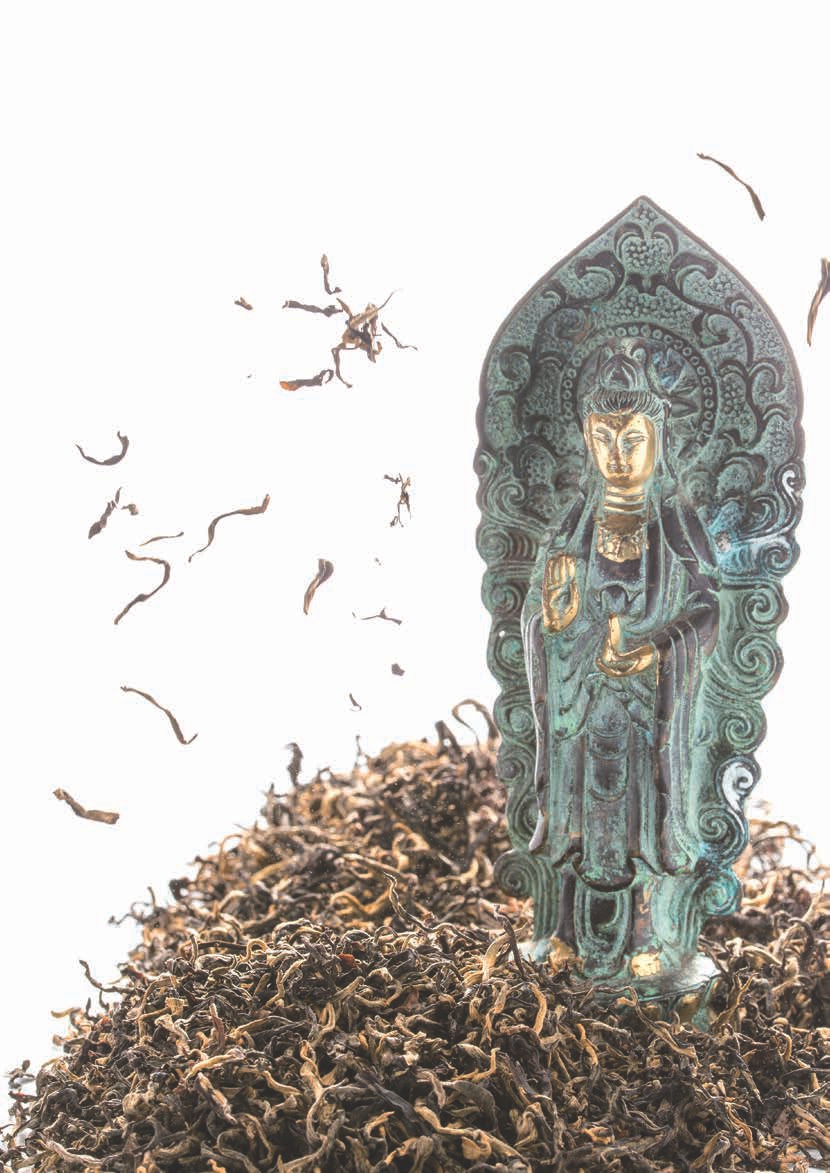
 | Daughter of the Forest (Sen Zhi Nu Er, 森之女兒) |  | Ai Lao, Yunnan |  | 2016 Dian Hong Red Tea |  | Ku Chuong Aboriginals |  | ~2500 Meters |
The tea we make ourselves is, of course, always the rarest and most treasured tea we send you! Not only does making tea ourselves mean traveling to the source of the tea (and carrying you with us in spirit), it also means putting our hearts in our hands and sharing a direct touch that we hope reaches out to all of you and solidifies this global community. We hope to continue sharing many more teas right from the source, bringing you a rich background to complement the amazing experience that is Global Tea Hut. As membership increases, we plan to devote more funds to continue traveling to tea-growing regions and finding farmers who produce tea organically, and who love the Earth and wish to protect it the way that we do, sharing their tea and their smiles with all of you.
Drinking tea with this community each month is a profound experience, and we are always blown away by how different the tea is once it starts arriving at its destinations and we all start to drink it together. As so many of you have verified, you can really feel the community in the bowl. This month will be extra special because of all the stories echoing through each bowl in spirals from our third annual Global Tea Hut trip.
Sometimes people in the tea world get jaded, hearing so many of the stories vendors use to sell tea. We know. After you go to a tea market in China and hear a few dozen wild claims about how the boss bought more tea than a region actually-factually produces: how they know him so well in such-and-such a village that he's family, or how his close relationship with some high government official allows him access to otherwise inaccessible tea - after all that, you start to tune out stories and rely solely on your own taste. Good teas don't need a story. They speak for themselves. "The truth is in the cup," as Master Lin always says. Relying on your own taste when buying tea is great, but let's face it: a tea with a story is more enjoyable! Isn't that true for anything? Isn't your favorite piece of jewelry the one with a story? Isn't your favorite piece of decoration or artwork in your house the one you found on that special trip? Most certainly, your favorite tea also has a story.
We believe that honest, heartfelt stories can enhance a tea and help connect us to the source. It isn't stories themselves that are the problem, but rather stories fabricated to sell tea or enhance its financial value. Stories improve tea, but not when they are financially motivated. We often speak of how you need to use your tasting skills when purchasing tea and practice common sense when navigating the tea world. There is a lot of misinformation, after all. But don't throw out the good leaves with the misbrewed liquor! There is still good in stories, just as there are tea vendors with spirit.
Since we aren't selling any teas, our trips to tea-growing regions will always be invested with a purehearted wish to deepen your relationship to Tea and this community. We have three goals in mind: first, to inform you, so that you can learn about tea, tea regions, processing and history. Second, to make the drinking experience personal. This brings myth and emotion to each bowl, beyond what this beautiful community already brings to the tea table. Finally, we hope to promote organic farmers who grow tea in sustainable ways, connecting them to the world and to each other, so that we can educate tea lovers about the effects their purchasing decisions have on the environment and the farmers' lives, as well as about the effects you each have on the future of tea production.
In May, a group of twenty-five Global Tea Hut members traveled to Yunnan in southwest China, which is the birthplace of all tea and Cha Dao. This trip was the third of what we hope will be many gatherings and tours designed to bring this community together in person. We hope to use our tea centers to create movement from this magazine, and the experience that surrounds receiving it, to actual tea spaces and then back home again. Receiving these envelopes always means more after you've visited our Center, met the authors in person, and had a chance to see how your financial support is used. We hope to host a lot more tea trips in the coming years, as well as big gatherings at the new Center, Light Meets Life, after it is built and running free tea courses!
We traveled to two places on this trip, which you'll read all about in the coming pages. The first stop on our trip, and the source of this month's tea, Ai Lao mountain in Puerh Prefecture, has a long story and is very dear to Wu De's heart...
Wu De is always ready to learn anything tea-related from anyone and will humbly receive any teacher, whether in his lineage or not. Amongst many teachers he's studied tea with, he learned a lot from a Taiwanese tea master named Huang Chuan Fang. Some of you may recall that he even discussed Master Huang's calligraphy in his book, The Way of Tea. Master Huang is a kind and gentle teacher who has a way of conveying the spirit of Tea simply and unadornedly, so that people from all walks of life feel inspired to let Tea change their lives. He also has a vibrant experimental streak, exploring new tea regions and testing new processing methods. This sometimes creates amazing teas. In the mid-2000s, Master Huang began spending more and more time in Yunnan, eventually settling there and only returning to Taiwan on occasion.

In 2007, Master Huang began exploring more remote areas of Yunnan - literally getting off the beaten path. He began hiking up as-yet-unpaved roads to more remote villages that other tea connoisseurs weren't yet exploring, often uncovering amazingly clean and stunning teas. Around that time, Master Huang started visiting the village of Qian Jia Zhai in the Ai Lao mountain range. While there, he met the amazing Ai Li Juan, a tea lover and producer with the same verve for bright, clean and old-growth teas. He began producing small batches of tea with her burgeoning company and the two formed a powerful business partnership. Around that time, Wu De met Ms. Ai at a tea expo in Malaysia, where he was visiting his master. Her strong personality, friendliness and love for tea made Master Huang's flattering introduction unnecessary - the two were fast tea brother and sister. It also helped that her tea had more than an amazing liquor; it had an amazing story as well!
Years later, we left for our second trip to Ai Lao, traveling by bus for more than fifteen hours from the capitol of Yunnan, Kunming. Some of us were returning from the first Global Tea Hut trip in 2014, but most were new faces. We arrived at the beginning of the Ai Lao range late at night. The Ai Lao mountain range is huge, extending hundreds of square kilometers. (The Nature reserve alone is more than 500 square kilometers).
Our destination was Qian Jia Zhai village, which literally means "Thousands of Families." It is located in Jiu Jia Township, Zhenyuan County, in the heart of the Ai Lao range. There are around 16,000 people spread out over Jiu Jia Township, most of them rural farmers. Until recently, there were no roads to the village and everything was carried in and out by donkey. The elder generations still tell stories of those days, reminding their children and grandchildren not to take their modern amenities for granted. There are 4,700 acres of tea forests here at an altitude of 2,000 to 2,500 meters. And these tea forests have a story that left Wu De agape when he first heard about them in 2007.
As Master Huang described the tea-growing situation there, Wu De's heart leapt, for it sounded like a solution to the environmental degradation happening in Yunnan - much of which had dampened many of Wu De's two dozen or so trips there. In fact, he has even cried for Tea. Seeing trees that have been part of a people's cultural heritage for centuries killed by unnecessary chemicals, like fertilizers, felt to him like someone spray-painting a Ming Dynasty painting. He remembered crying in the embrace of another of his teachers, Zhou Yu. A reporter present asked another member of the group why the two were crying. The answer later overheard in the video was, "They just love tea." As an optimist, though, Wu De is always on the look out for inspirational stories, stories of hope. And he found one in Master Huang's description of Qian Jia Zhai.
The tea in Qian Jia Zhai is completely controlled by a co-op. There is little that any one individual can do to spoil the old-growth tea, its protected environment or any aspect of its processing without the other members of the group coming down on them. This means that personal greed cannot destroy what rightly belongs to no single human. Having lived for hundreds, if not thousands of years means these trees have a right to see future generations of people who tend to them rather than claim "ownership" over them, who pass them on to the next generation as healthy as they found them! From the time Wu De first heard about the Qian Jia Zhai co-op, he developed an interest in visiting, and from then on kept an eye out for any and all tea from Ai Lao, tasting a lot along the way.
To continue our story, in 2010, Mr. Liang, a dear friend of our Center, whom many of you have met, came back from visiting Ms. Ai with a small batch of Ai Lao bings (a bing is a discus of puerh). This 2010 cake is amongst our all-time favorite teas. Many of you have tried it, or were even lucky enough to purchase a cake of it when it was still available. And, believe it or not, that very tea was the first-ever Global Tea Hut tea of the month! (Be sure to go back to the first issue and read about it on our website!) Sharing that tea hundreds of times around the world ensured that one day we would take Ms. Ai up on her offer to visit her village and make some similar tea, which we finally did in May of 2014.
On that first trip in 2014, Ai Li Juan made us feel like family, so much so that we came to know her as "Auntie Ai." She housed and fed us, guided us to the tea trees and showered us with traditional songs and heartfelt smiles. Even though we arrived late at night, she was there in high spirits to greet us again this time, remembering each and every one of the returning visitors and welcoming the new guests with embraces. When we left three days later, she shed a tear, saying she didn't want us to go. She said she hopes it isn't another two years before she sees us and promised to visit the Center in Taiwan. Auntie Ai is an amazing, strong and modern woman: a single, tribal woman in rural China who controls an international tea production company! She has been a member of the co-op in Qian Jia Zhai since 2005, tending to more than 400 hectares of tea. In 2012, Auntie Ai took all her savings from tea production and began construction on a tea processing and pressing facility that includes guest rooms for friends as well as a museum and theater to preserve traditional Ku Chuong culture. When we went in 2014, her center was still under construction. She proudly showed us the foundation, smiling and saying that next time, we'd be completely in her care. It was nice to see the final building on this trip and stay with her, surrendering to her very "complete" hospitality.
The Ku Chuong tribe has around 40,000 people with some heritage living throughout China and Laos. Until very recently, the Ku Chuong were still living a simple lifestyle in the mountains of Ai Lao - completely self-sustained. In the last decade, they have moved down from the original village site, which is now part of the protected National Reserve, to settle in a small town below. They have paved roads leading to the capital and some modern amenities. Evidence of their traditional culture still abounds, however, in the gloriously colorful clothes of Ms. Ai as well as the way she and her family cook and farm.
Auntie Ai told us that in the '90s, some farmers cut down a lot of the old tea trees to grow tobacco. Some of the elders then tore up the tobacco in protest of this. Our faces grew long, and a few of us looked down at the ground. "Cheer up," she said. "Those old tea trees are as strong as the mountain. They have deep and vast root systems. Even though many were cut down, after the land was returned to the National Reserve, many of the trees came back as though they'd never been cut!" And sure enough, she was right! The trees are strong and healthy again.

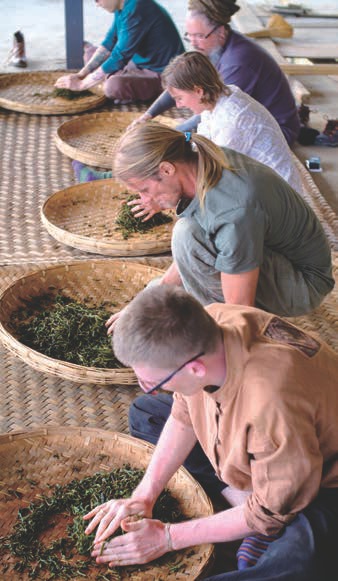
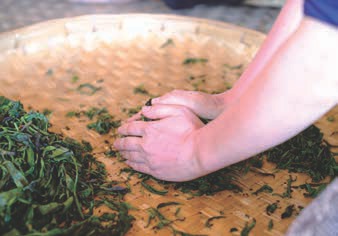
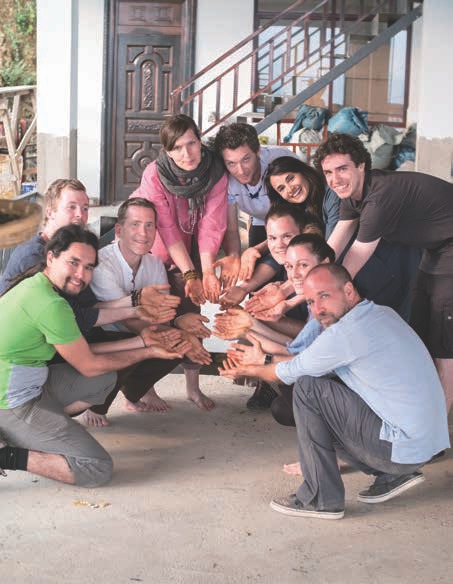

Red tea from Yunnan is often called "Dian Hong." "Dian" is an aboriginal word for Yunnan, so this just means "Yunnan red." As we have often discussed, "red tea" is what is often mistakenly called "black tea" in the West. Ordinarily, a name doesn't matter so much and we wouldn't take the time to correct this age-old mistake (most vendors don't). But in this case, there is an important issue that a Chajin (tea person) will face if this mistake isn't corrected: there is another genre of tea in China called "black tea." So if you call red tea "black," then what do you call black tea? The problem began because early trade between Chinese and Europeans was limited to the ports, and most merchants/sailors didn't see the tea trees, farms or processing methods and learned what they knew through broken Pidgin English on the docks, often from Chinese merchants who didn't care to correct them. Actually, Europeans used to call Oolong tea "black tea" as well, probably because it has the word "black" in the name ("oolong" means "black dragon").
In Qian Jia Zhai, they call the red tea "Daughter of the Forest." We didn't have time to pick the tea ourselves, but we got to see the trees. The tea all came from trees that are two to seven hundred years old. Red tea is fully oxidized. It is picked and withered for a long time, sometimes with machines that blow hot air into large piles of tea. Our tea this month wasn't withered with such machines, but rather naturally withered, spread out on bamboo mats. Making red tea is a simple process. Even though Yunnan is more famous nowadays for puerh tea, it has always been a region of red tea as well, producing as much or more red tea as other regions for some decades. In fact, puerh's rise to fame is rather recent; in Yunnan there was more red tea than puerh by volume fifteen years ago. But our red tea isn't a plantation tea, since it was grown semi-wild in the forest.
Yunnanese red tea, called “Dian Hong,” is processed a bit differently from most red tea in the world. First of all, there is more variation in the technique in rural Yunnan. Other red-tea-producing areas have become more standardized and incorporated more machinery, which is slowly making its way to Yunnan as well, since tea farmers are earning enough to purchase it. Secondly, Dian Hong is mostly sundried, whereas most red tea is dried in ovens. Since it comes from largeleaf trees and is often less oxidized, this sun-drying contributes to the “puerhy” flavors of Dian Hong and to its ageability as well.
Daughter of the Forest has its own regional idiosyncrasies. Our tea was picked early in the morning and withered for a few hours to remove moisture and start the oxidation process. When we arrived, the tea was all ready to be rolled. We divided it into twenty-some trays and began rolling. Many red teas are rolled for a long time—up to ninety minutes, in fact—but we rolled our tea much less. Auntie Ai came around and inspected each person’s tea, smelling it to see if it was done. No one rolled for more than thirty minutes. Two years ago, we withered the tea in traditional cloth bags, twisted up to compress the tea. This year, there were too many of us, and too much tea, so we compressed it into a large tub and covered it with cloth, leaving it to wither overnight. Early the next morning, we spread the tea out on large mats to dry in the sun. Of course, the four kilograms of dried leaf we produced was nowhere near enough for this growing global community, so we added another batch that Auntie Ai herself made. She said she also wanted her heart in this month’s tea along with everyone else’s on the trip.
As we were processing this month’s tea, we made several announcements asking the participants to think of all our tea brothers and sisters who were not present and put their good wishes and prayers into the tea, as it would eventually be sent to all of you. We hope you can feel all the love and good intentions that were put into this month’s tea, from all of us and from Auntie Ai, who expressed a heartfelt desire to meet you all some day.
You may have noticed some unique, longer, darker leaves in your tin this month. Those are amongst the ones that we processed by hand ourselves. The reason they are different is twofold: First, our rolling is not as skilled as Auntie Ai. And second, we arrived late in the season (May) - too late, in fact - so the raw material we used was late-season tea with larger, inferior leaves (fewer buds). Ordinarily, such tea wouldn't be brought to market. Auntie Ai picked it for our education and for the pleasure of sharing tea that was handmade by Global Tea Hut members with you all. Anyway, we have found the blend to be quite lovely! We worried that maybe the two kinds of tea would not fuse or find harmony in the bowl, but they do. The later-season, rougher tea we made brings a bit of briskness and strength to the smooth, sweet and malty tea that Auntie Ai made for us. They are deeper and stronger together than apart, and the Qi longer-lasting and more yang. They lovingly embrace one another and feel very much like one tea.
Daughter of the Forest is one of our all-time favorite red teas. It is strong and juicy, and very patient. The protected ecosystem of Qian Jia Zhai thrums through the leaves, the liquor, the bowl and even your hands before you take the first sip. Try holding the bowl for a second before taking a drink and see if you can feel the forest by touch. Daughter of the Forest has a deep yang Qi that enlivens you and changes the rest of the day. It is, of course, best drunk in the morning or early afternoon. Share it with as many loved ones as possible and watch how it opens hearts and eyes to the moment!

This is a tea that summons visions of mountain peaks rising above the clouds, with dark green patches and contours of red soil: a familiar memory I glimpse when drinking fine Yunnanese red tea. The energy in the tea can be felt swelling up my spine, residing betwixt my shoulder blades and occiput as a soothing, tingling sensation. It continues to lift me from my shoulders before gently mellowing in my chest, as if a hearth was lit that warms me from the inside, though I remain externally cooled. As the leaves float listlessly around the bowl, the fragrance of plum blossoms, honey and a mélange of spices ascends to titillate my nostrils and bring me deeper into the moment. The red color reminds me of a sunset diffused through smoke from the cycle of the forests on a warm, summer evening. After the tea, a sweetness lingers. I taste a medley of raspberries, burnt sweet potato, tobacco and raw cacao.
As soon as the water touched the leaves, the aroma of tranquility came over me. Upon the first sip, I immediately felt the warmth and energy my tea brothers and sisters had put into it. I felt calm and grounded; mental clarity and consciousness allowed me to think and feel in the present moment. As the tea opened up, the taste of sun-kissed cherries heralded the coming of summer!
In part, I love Tea for Her ability to bring presence into my life. It's when I'm most present that I feel most alive, and so a lot of my most precious time on this earth unfolds when I'm drinking tea. In part, I love red tea for its versatility to be drunk throughout the year and to energize me. And in part, I love this particular red tea for its ability to connect me to a time and place that I wasn't there for, yet now feel like I am.
Usually with red teas, I feel the warming of my heart space, but I also hear my monkey mind quietly running through thoughts. I experienced both when drinking this tea; however, I also felt this comforting feeling of emptiness, almost like I was an empty tea bowl, accepting whatever medicine was placed inside.
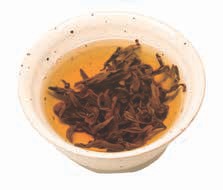
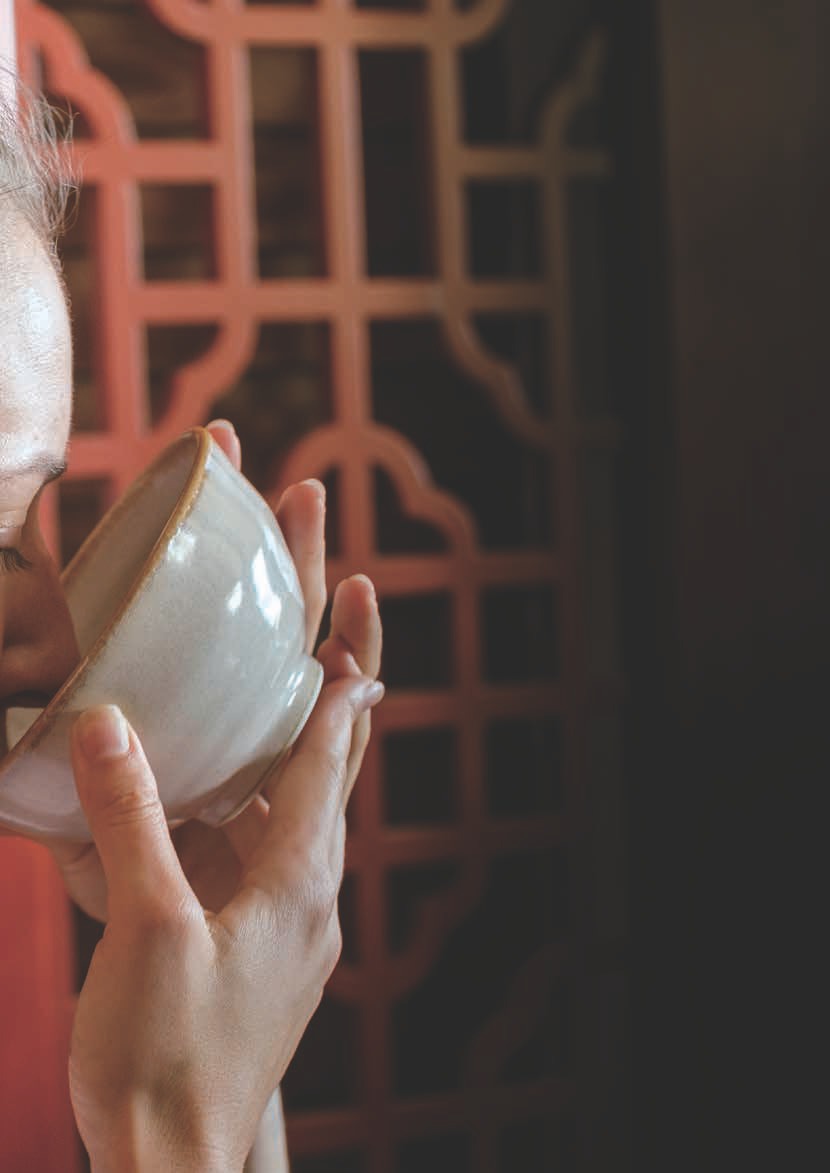
People new to brewing tea often ask is what amount of tea at what temperature and steeped for how long. We understand that many Western tea vendors approach brewing instructions this way, and that such directions can indeed help people who are first starting out. However, these three parameters are actually infinitely more complicated than they may seem. After all, if we were to suggest five grams of this month's tea, that may be too much or too little leaf, depending on the size of your brewing vessel. And then there is the question of what material your vessel is made of. Water at 95 degrees, but what kind of water and how was it boiled? For example, wouldn't you rather have under-boiled spring water than tap water at the correct temperature? And what about over-boiled water versus water at the right temperature that was microwaved? Obviously, these parameters are only a very general starting point.
Ultimately, we have to learn to use our senses to judge the appropriate amount based on the pot we're using, gauge the water temperature by sight and sound and know the steeping time by feeling the tea as it releases itself into the water. To get to this point, we will need something else, though. And this tool will be one of the most useful brewing tips that we have ever shared with you: a willingness to make mistakes.
Let go of the idea that there is a perfect bowl or cup. Be willing to practice and make mistakes, and, more importantly, learn from them. If you oversteep, correct yourself next time. Find the perfect point through experience. We could tell you that red tea, especially Dian Hong, responds very well to higher-temperature water or that green tea can be pleasant when brewed at lower temperatures. But those directions will never compare to actually experiencing the difference! And if you only follow the instructions, you will never really find the perfect steeping time, which is a balance that cannot be taught, as it is founded on experience.
Practice letting go of parameters and asking the tea what it wants. Listen to it as the liquor talks to you and tells you if you put too much or too little (it's better to start with too little, as you can always add more). Listen to the liquor and it will tell you if it is over or understeeped. Learn to love your mistakes, as they are Tea's way of guiding you towards mastery. She will lead the way if you listen and adjust, especially if you are then listening to the way a proper bowl feels in the hands, smells and tastes and circulates in the subtle body. The best brewing advice, in other words, is just that: listen!